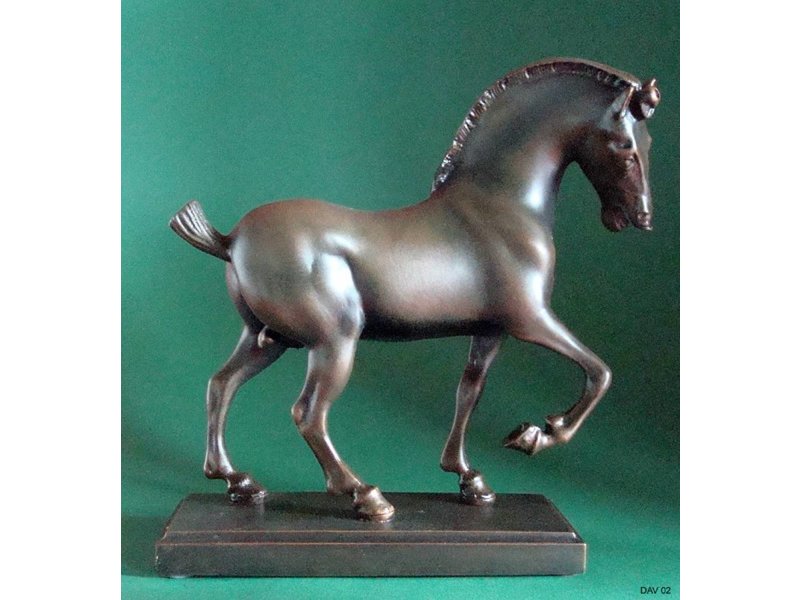Mouseion Il Cavallo - Da Vinci School
Leonardo's horse Gran Cavallo
This horse is a small version measuring 24 cm high, made in resin and released under license in the color bronze. This replica horse has an interesting story summarized in Wikipedia (see link below).
Background information:
Leonardo Da Vinci spent a lot of time studying perfect forms during his lifetime. This included a study of the shape of the perfectly proportioned horse, which he called a miracle of nature.
The horse was to become the largest statue in the world, 'Il Cavallo'. He never got around to it, but did leave behind the calculations for his super-horse.
War
Da Vinci was commissioned in 1482 by Lodovico Sforza, Duke of Milan to create a gigantic statue of a horse. He spent seventeen years researching the possibility, but the horse never materialized. By 1499, the calculations were ready, but there was no bronze to cast the horse; all the metal went into the war against the king of France. To make matters worse, the molds were also lost and the French soldiers turned the clay model into grit.
Impossible
Da Vinci would always have remained mourning the fact that his masterpiece never came to fruition. However, technicians were convinced, based on the calculations, that the horse could never have become a reality. There were too many technical problems. For how could such a large amount of hot bronze ever have been cast? And how could such a heavy horse remain standing on three legs? The answers are presenting themselves now - more than five hundred years later. Computer models and data from Da Vinci's own manuscripts provide the necessary explanation.
165 seconds
The seven-meter high and 70-ton bronze horse was to be cast in one movement and within 165 seconds. Da Vinci had thought of two ways to cast the bronze, and both ways were feasible; the horse could be cast both horizontally and vertically. "However, he (Da Vinci, ed.) should have left the position of the legs loose, because a 20-meter deep hole to cast bronze in was not safe," believes researcher Paolo Galluzzi.
Casting template
To cast the horse, Da Vinci wanted to use an indirect casting technique. This involves reusing the molds to cast the core of the sculpture as well. It is known that this technique was frequently used by the Greeks, but it had never been proven that Renaissance artists also knew and mastered the technique.
Sensor
To ensure that the casting would be done with the right temperature and timing, Da Vinci used furnaces. "The kilns opened as soon as a certain sequence was achieved. These were controlled by pyrotechnic sensors." The sensors reacted as soon as the molten bronze reached them. That was the signal to open the next furnace.
Balance
"The model shows that everything was carefully planned," says Alessandro Incognito, director of the company that performed the computer simulations. "The most weak spots during casting, where the bronze cools faster, turn out to be the least important spots for the horse's balance."
Wikipedia: "Leonardo's Horse" -.
Edit: The gigantic piece of bronze is now in Milan. It is a horse as big as a house, 7.2 meters high and 8.7 meters long. The foundation that commissioned the horse (cost at the time: twelve million guilders) says the statue is strong enough to withstand earthquakes.










